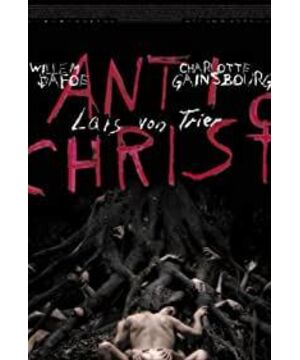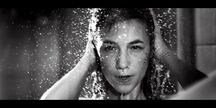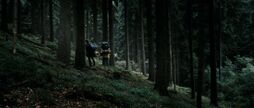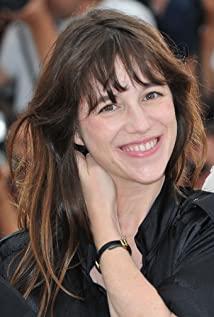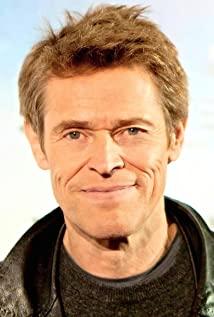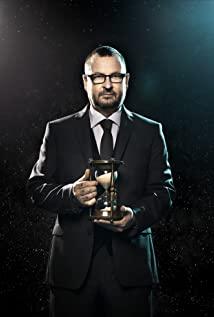The text is transferred from: Love and hate have the same root, desire and sin have the same origin
"The Antichrist" opens with a breathtakingly perfect interpretation of a family tragedy-white snowflakes fluttering outside the window, accompanied by the high-pitched and euphemistic arias in Handel's opera, inside the house, not far from the window sill In the distance, a couple is forgetting their feelings, the slowly rotating washing machine, the crystal drops of water are dripping.... Poetic mood. And those elegant and gorgeous black and white slow motion, but with the method of parallel montage, they are recording the process of how a toddler falls from a high window when his parents are greedy.
After the tragedy of losing a child, the picture changed from black and white to color. After a month of treatment, the mother (Charlotte Gainsbourg) was discharged from the hospital, and her husband (William Dafoe), a professional psychiatrist, was sent home. continue to take care of her. In order to treat his wife's trauma, the husband, who is a psychologist, took his wife back to the place where she used to vacation with her children, a forest called "Eden". As the story progresses, we learn that the original wife was preparing to write a dissertation on the Holocaust of women in history while she was vacationing with her son at the "Eden" forest cabin. In the attic of the wooden house, the husband found the materials that the wife had collected, most of which were related to the persecution of witches in history. Based on professional habits, the husband infers that the wife's current "psychopathological symptoms" are not only related to the loss of a child, but may also be related to her academic research. The woman may have experienced some kind of spiritual crisis while on vacation with her son in Eden. This was soon confirmed in the mouth of the wife: nature is Satan's church"...Everything in the forest seems to be from the beautiful nature Transformed into an uncontrollable devil's dwelling....Lars von Trier, after "Dancer in the Darkness", once again aimed the camera at the extremely dark place of human beings.
intertextuality
"The name of the film, The Antichrist, comes from Nietzsche's book of the same name. This condemnation of Christianity, I've been reading since I was 12, but never finished, it's been sitting on my bedside table. In fact, I feel spiritually closer to my compatriot August Strinberg, a writer who is good at depicting sexual conflict. Lars von Trier uses religion as a theme to express iconoclastic and Anti-system is still the original intention of this maverick director to make the film. Nietzsche's "Furyan" and "God is Dead" show that when human beings question the social morality of the God they believe in and their representatives, The fear, anger, and spiritual emptiness and collapse that arise from the depths of their hearts. "Any form of anti-nature is depravity", in Nietzsche's view, Christianity is anti-natural life and sees the instinct of life as sin. These arguments may It fits the behavioral logic of the hero and heroine in the film and the source of their pain.
The narrative technique of the fable is subtly combined with the expression content of the film. It is divided into four chapters. The first three chapters are all related to the images of the three fables. "Destruction", the fourth chapter "Three Beggars", the allegorical image at the end is the astrological map of the sky. The appearance of the three animals hints at the mental state of the characters in the film. The first allegorical image is the "raven", which symbolizes "sorrow" - it eats a bird on the ground. When a woman sees this scene, she thinks of her child who fell to her death; the second One is "deer", which is a metaphor for "pain". This is a deer giving birth. It kept licking itself and biting its own intestines out, alluding to the couple's relationship of self-mutilation and mutual abuse. The third allegorical figure is the "fox", which heralds destruction. The woman was finally completely defeated by deep self-blame. The "three beggars" can be seen as the correspondence of the three saints of the East mentioned in the New Testament. The "New Testament" says that when Jesus was born, three magi came from the east with gold, frankincense and last medicine, among which gold is a gift for kings, frankincense is a gift for saints, and the last Medicine is for the dying. If the "Three Saints of the East" represent the brilliance of rebirth, then the "Three Beggars" mean the stench of death. In the film, when the dying man asked why the woman didn't kill him, the woman replied, "It's not yet time, and the three beggars have not come. When the three beggars come from the east, someone will die." The three beggars actually refer to those three animals: a doe half-delivered, a fox nibbling on the corpses of the same kind, and a crow in a cave. Satan as the Antichrist, when he sends a person to die, should undoubtedly also have three things that match the characteristics of Satan to correspond to the three magi in the Bible. In this way, the director subverts the biblical text. At the same time, "Three Beggars" is also the name of a poem by Yeats, which explores the theme of "Do people want less and get more, or want more and get more". In the film, as the incarnation of the "three beggars", deer, fox and crow respectively reflect the desires of human beings, and it is the word "desire" that runs through the whole film, and the last chapter is named "The Three Beggars". ", seems to imply the moral of the whole film. The play also involves a lot of "Floyd complex". For example, the heroine said, "People don't study Freud anymore." This may also express the helplessness that Freud's thought is no longer brilliant and can only exist as the second leading thought of psychoanalysis. Based on director Lars Von.
2. Women and men
Except for the child who fell from the windowsill, the whole film can be said to have only two actors, Willem Dafoe and Charlotte Gainsbourg. The film only supports the whole story through the related events of the male and female protagonists, and even their names are only "he" and "she". The latter is the core character of the whole film. The woman represented by "she" is not only a contradiction It is also a contradictory aggregate in itself.
It can be read from the film that the source of the wife's pain is not the bereavement itself, but the real reason is that she realizes that human nature (nature) is evil, but cannot get rid of its control. As the wife said in the film: "Women can't control their own minds, it is nature who controls their minds." She equates "natural" with "desire". Because of "desire", Adam and Eve were expelled from the Garden of Eden, because "desire" ", their children died in heaven. Her husband's psychotherapy can't heal her at all, she can only paralyze herself again and again by indulgence. Just as the wife in the film said: "Women can't control their own psychology, what controls their psychology is nature .
This idea of "desire---nature---evil" explains, from one level, why the wife interprets the data on "persecution of women" collected before as "women are inherently evil". Explains why the wife asks her husband to beat her when they have sex again, and later "cuts" herself - because she believes that when "nature" appears in the form of a devil, she should be punished. And she can't do without desire and the product of desire, so, in order to keep her husband and son away from her, she nailed a stone mill to her husband's leg and hurt the child's foot. She makes it difficult for them to leave herself by tying up their mobility. From another level, when the wife returned to Eden with the confession of her "desire", the previous academic research presented another "truth", which resulted in her having a psychological "inversion", that is: The witch persecution in history is nothing more than that men blame all the desires between the sexes on women, while men act as the embodiment of reason and the savior of history. This kind of psychology triggered her revenge against men. The wife is deeply caught in the contradiction between original sin and her nature. She feels the sin of "natural", but she is unable to overcome it, and is even less able to overcome it. Ultimately, under huge pressure, it leads to the destruction of men and the destruction of herself.
The wife is a revenge for "self-indulgence". She accepts the teaching of Christianity's original sin and wants to counteract "desire-natural-sin", but she has become an incarnation of Satan in her behavior, and she is bloody. , Violent, barbaric, lost the gentleness and kindness that women should have, like negative and negative in mathematics, and finally appeared in the image of "Antichrist".
A husband who runs rationality through to the end always analyzes his wife's pain according to his own logic, but he cannot enter his wife's heart at all. In the dreams that appear several times in the film, the wife's fear of the grass and nature, the husband has not been able to open the truth even though he has interpreted it in many ways. Therefore, he cannot dispel his wife's fear. He regards his wife's problems as pure mental illness, and has been trying to use psychotherapy to "recover" his wife. As a typical representative of a modern male, he has strong logic and rational thinking, and sees everything with rational eyes, including everything in Eden... Deer, fox, crow, and acorns falling on the roof on the sound.
From a Christian point of view, indulging in fanatical nature (nature) and indulging in indifference to reason are both "anti-Christ". In the late Middle Ages, anatomy and astronomy flourished. Scientists tried to dominate everything with human reason. They spied on the mysteries of the universe and life. This scientific trend of thought was the most opposed to Christianity, because it subverted mankind's reverence for "God". It broke the humility of human beings to "I", which gave birth to "fatal conceit" and triggered the crisis of human self-destruction. Therefore, an atheist like a man who advocates science and reason is also "anti-Christ", and his scientism tendency is Christ's greatest natural enemy.
3. Image image
"I remember watching Tarkovsky's The Mirror. It was a revelation! Movies are also inspired by life and religion." - Lars von Trieu
The film's preface (parents love each other, son stumbles and dies) and epilogue (after the husband kills his wife, walks out of Eden, walks through groups of female corpses, but countless women walk into the forest) two chapters, both. Processed with black and white footage. This way of echoing before and after makes the film complete in form. In the middle four parts of the film, the picture not only changes to color, but also forms two extremes in imagery. One is that the dense forest presents a dreamlike illusion, elegant slow motion shots, the golden section of the perfect composition, soft and delicate light processing, accompanied by elegant and lyrical opera arias, and Gainsbourg stepping lightly. Moss-covered ground in the early morning....it's all beautiful. Then, pure beauty dies, darkness falls, a scene of physical self-mutilation and brutal sex, violence and blood, darkness and horror fill the screen.
This alternation of black and white and color images, as well as the scenes with a strong sense of religious ritual, allow us to find traces of "Mirror". The alternation of surreal and realistic scenes makes it more similar to Tarkovsky's dream performance. But the expressions of the two are irrelevant. In "The Antichrist", Trieux makes some natural scenes deviate from common sense, and expresses the surreal through the undulating effect of the picture. For Tarkovsky , Even surreal things like dreams should be expressed through naturalistic methods. In addition to the difference in the concept of images, the belief in religion between the two is also very different. Trieu is both suspicious and despairing of religion. By contrast, Tarkovsky genuinely believed that religion was the redeeming force.
It is worth mentioning that Anthony Dodd Manto's first-class lenses - whether it is low-light monochrome, fixed-camera images, or rougher handheld photography in wooden houses and dense forests - The pictures are all beautiful.
4. Creation Theory
"Since I indulged my imagination and instinct, rather than intellectual factors, during filming, it's hard to say what my intentions were...I gave the actors a lot of freedom! The full script is only 60 pages. Strange, but this is the first time I haven't really written about my film. - Lars von Trier.
In an interview with Le Figaro, von Trieu said: "I didn't shoot the genre films that Hollywood people are passionate about, and I don't have the power to control the crew, I can only direct the crew... Inspiration, it Always there, so that I can get out of the hemp that has flooded me...because I'm very opposed to filmmaking, I like to add my own personal things to some type of film that everyone agrees with.... These things can be plot and story, or dance and music. Like I used to shoot "Breaking the Wave" and "Dancer in the Darkness"....I think "The Antichrist" is a romantic movie myself, it It has all the elements of a romantic love movie. I even think its style is very close to the world of Edgar Allan Poe."
From a creative point of view, the film Antichrist applies effect theory, first establishing a certain effect to be achieved, and then thinking about the text for the pursuit of this effect, in this way, the narrative serves the theme and creative intent , to express and create the atmosphere and effect the author wants, the narrative itself is not important. This theory was first proposed by the horror novel master Edgar Allan Poe, and is widely used in horror novels and film texts. Hitchcock, Conan Doyle, Verne and others are deeply influenced by this theory . From this point of view, the style of the film is indeed "similar to the world of Edgar Allan Poe"
For Nietzsche, the classical linguist, the composition of the biblical text and its history, even the entire history of Christianity, is a political history of signs and interpretations. All changes in meaning brought about by fictional narratives are an ex-ercise of power. In fact, the film was supposed to be released in 2005, but because the producer of the film revealed the ending of the film, von Trier re-edited the script and re-shot, which shows that the plot itself is not important, it is Not a drama at all.
5. Others
"I make films to express a fear that is close to the real darkness, not to let them experience what's in my heart. My films are part of the world, so it's not a big issue whether the audience can understand it or not." ----Lars von Trier
"The Antichrist" was an entry at the 2009 Cannes Film Festival. The film was shot in a grove on the edge of Cologne, Germany. The entire film's investment was only $11 million. Among them, the Danish Film Academy invested 1.5 million. The rest of the funding comes from almost every independent film company around the world. These companies are located in Germany, Lithuania, Brazil, Russia, Estonia, Poland, Italy, India, Iran, Bulgaria, Romania and Greece. Von Trieu's own film company also invested part of the money. The animals used in the film - deer, fox and crow - were previously trained in the Czech Republic.
Because of his disrespect to the gods, the director of "The Antichrist" was attacked one-sidedly. People scolded him overwhelmingly and asked him to apologize to the audience. To this, von Trier solemnly replied:
"No, I never apologize."
View more about Antichrist reviews


